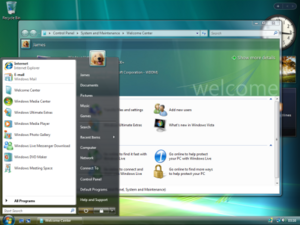Microsoft Windows: Difference between revisions
imported>Eric M Gearhart |
imported>Joshua David Williams (wrote new introduction. I don't think we need the wikipedia tag now.) |
||
| Line 32: | Line 32: | ||
Microsoft Windows | '''Microsoft Windows''' is the name of several families of [[closed source software]] [[operating system|operating systems]], first released by [[Microsoft]] in [[1985]]. Windows is largely known as holding approximately 90% of the desktop operating system market<ref name=linuxworld>[http://www.linuxworld.com.au/index.php/id;940707233;fp;2;fpid;1 IDC: Consolidation to Windows won't happen] www.linuxworld.com.au</ref> and, as being the number one targeted system for [[malware]], the great number of security threats it has introduced throughout the years. Windows is a [[graphical user interface|graphical system]], and was one of the first of its kind to allow input from such devices as a [[mouse (computers)|mouse]]. Before Windows, users of the Microsoft operating systems were limited to plain text operations. | ||
Computers running Windows have commonly been referred to as [[Personal Computer|Person Computers]] (PCs) for many years, as opposed to [[Macintosh|Macs]], [[Workstation computer|workstation computers]], and [[Supercomputer|supercomputers]]. A Windows system is typically found in the home and office environment, completing tasks for nearly every conceivable type of work, from text documents to displaying [[X-ray|x-rays]] and being used for various types of leisure, such as [[gaming]] and watch [[television]]. | |||
==History== | ==History== | ||
Revision as of 12:33, 7 April 2007
| Microsoft Windows |

|
| Screenshot of Microsoft Windows Vista |
| Website: http://www.microsoft.com/windows/ |
| Developer: Microsoft Corporation |
| OS family: Windows NT-based |
| Source model: Closed source |
| Latest stable release: Windows Vista / November 8, 2006 |
| Supported platforms: x86, x86-64 |
| Kernel type: Hybrid kernel |
| Default user interface: Graphical user interface (Aero) |
| License: MS-EULA |
| Working state: Current |
Microsoft Windows is the name of several families of proprietary software operating systems developed by Microsoft.
Microsoft Windows is the name of several families of closed source software operating systems, first released by Microsoft in 1985. Windows is largely known as holding approximately 90% of the desktop operating system market[1] and, as being the number one targeted system for malware, the great number of security threats it has introduced throughout the years. Windows is a graphical system, and was one of the first of its kind to allow input from such devices as a mouse. Before Windows, users of the Microsoft operating systems were limited to plain text operations.
Computers running Windows have commonly been referred to as Person Computers (PCs) for many years, as opposed to Macs, workstation computers, and supercomputers. A Windows system is typically found in the home and office environment, completing tasks for nearly every conceivable type of work, from text documents to displaying x-rays and being used for various types of leisure, such as gaming and watch television.
History
There are two development tracks of Windows that were kept updated through subsequent versions, the versions of Windows which still relied on an MS-DOS subsystem, and Windows NT, which was written from scratch on a completely new, Hybrid microkernel design.
Windows/286 through Windows ME
Windows started life as an attempt at creating a graphical user interface on top of MS-DOS. The first "breakthough" version of Windows that started gaining in popularity was Windows 3.0. Earlier versions weren't feature complete in various ways yet, such as they didn't support overlapped windows, and they couldn't run MS-DOS programs very well. Windows 3.0 changed all that, and combined with the popularity of Microsoft Office on Windows, popularity of Windows boomed.
Windows NT through Windows Vista
References
- ↑ IDC: Consolidation to Windows won't happen www.linuxworld.com.au